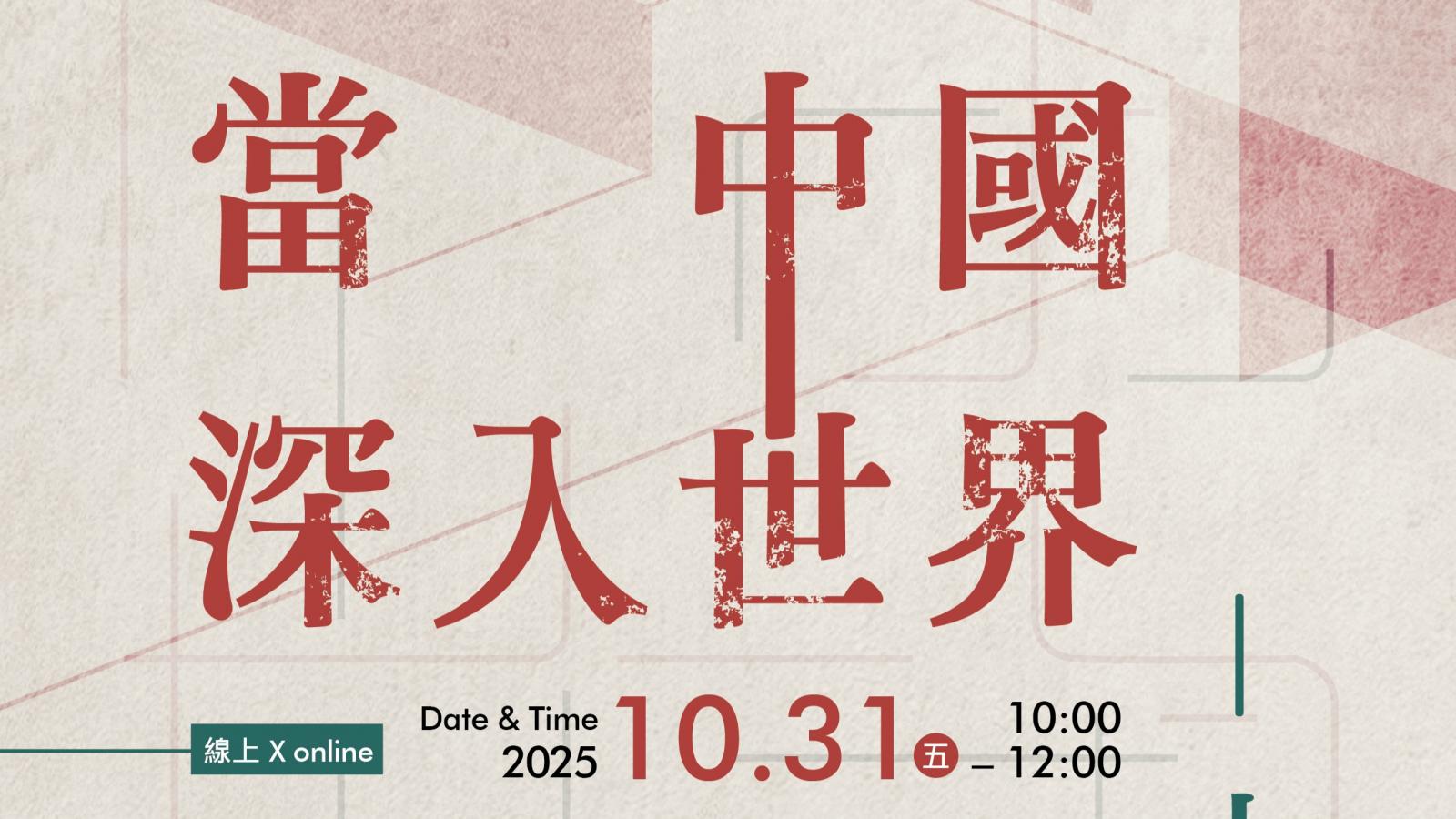

側記|中國、「一帶一路」及其對數位治理、威權和人權未來的影響
2025-01-17
活動名稱|中國、「一帶一路」及其對數位治理、威權和人權未來的影響
日期|2025-01-17 14:00 - 16:30 (台北時間)
地點|線上會議
講者|Michael Caster (Article 19 中國項目主任)、 Lobsang Gyatso Sither (Tibet Action Institute 技術總監)、 鄭司律(曾任香港工黨副主席,自《國家安全法》實施以來移居臺灣)、 Mahesh Kumar Kushwaha(尼泊爾社會創新與外交政策中心研究員)
主持人|Dolma Tsering (國立陽明交通大學文化研究國際中心博士後研究員)
主辦單位|國立陽明交通大學文化研究國際中心
活動連結|https://iccs.chss.nycu.edu.tw/zh/video.php?USN=564
活動錄影|https://iccs.chss.nycu.edu.tw/zh/video.php?USN=564
側記作者|Hanna Hlynenko, IACS
所屬子計畫|晶片時代與數位治理 & 遷移、不平等公民、批判法律研究
子計畫主持人|劉紀蕙、邱羽凡、潘美玲

On January 17, 2025, the International Center for Cultural Studies held an online forum, “China, BRI and Implications on Digital Governance, Authoritarianism and Future of Human Rights,” dedicated to the exploration of China's digital influence, its effects on social control, digital governance, and human rights in the Global South.
The Digital Silk Road: China's Infrastructures of Repression
Michael Caster, head of the Global China Program at Article 19, introduced an analysis of the Digital Silk Road (DSR) – an extension of China’s broader Belt and Road Initiative (BRI) focused on exporting technology and digital infrastructure. He identified the DSR’s legal, normative, and institutional frameworks in China, and its implications for global digital governance.
Among the laws that form the backbone of China’s domestic digital infrastructure are the Cybersecurity Law, the Counter-espionage Law, the National Intelligence Law, the Data Security Law, and the Critical Information Infrastructure Security Protection Regulations. These laws allow the government to restrict internet access, gather information, retain data, monitor, censor, and control information through various infrastructures and networks. Alarmingly, we can trace the diffusion of these laws through adoption and emulation by other countries. Examples of this diffusion include Nepal’s National Cybersecurity Policy, Cambodia’s draft Cybersecurity Law, and Vietnam’s Cybersecurity Law, all of which reflect elements of China’s approach to digital governance.
The Chinese Communist Party has consolidated control over both public and private technology sectors in China. The main state institutions responsible for developing, implementing, and enforcing digital governance policy include the Cyberspace Administration of China, the Ministry of Public Security, the Ministry of Industry and Information Technology, and the National Development and Reform Commission. China’s normative approach to ICT is declared to stand on the principles of cyber sovereignty, multilateralism, and security and development. These norms legitimize and reinforce China’s governance model domestically and internationally.
To situate the DSR within a broader geopolitical context, Michael Caster offers insights into China’s national developmental plans. The Outline of National Standardization Development (2021) and the Notice of “the 13th Five-Year Plan” for National Informatization (2016) outline plans to strengthen standardization dialogues and deepen cooperation across Northeast Asia and the Asia-Pacific, reiterating China’s ambition to shape global internet norms. In 2022, China issued a white paper, “Jointly Build a Community with a Shared Future in Cyberspace,” which underscored China’s aspiration to expand global digital infrastructure, particularly in developing countries, positioning itself as a leader in international standard-setting.
China’s impact is deeply embedded in digital infrastructure in the Indo-Pacific. Meanwhile, Chinese export under the brand of the DSR is not limited to hardware and software; it extends to the principles and standards underpinning digital governance. Providing tools and frameworks to enable the rise of digital authoritarian states in the Indo-Pacific, China accelerates the decline of digital rights in the region. From its legal, normative, and institutional foundations, the DSR represents an effort to redefine global digital governance in ways that prioritize state control and security at the expense of openness and individual freedoms.
Xi's Expansion of Digital Repression of Tibetans
Lobsang Gyatso Sither, a director of technology at Tibet Action Institute, offered his account of the changes in China’s strategies of digital repression in Tibet that took place under Xi Jinping’s leadership. Before Xi’s rise to power in 2012, the state’s policies focused on integrating Tibet into the broader Chinese system, which still left room for preserving Tibetan identity. After 2012, the focus shifted toward total assimilation – a deliberate erasure of Tibetan language, culture, and religion. This shift is evident in the increasing censorship of news and narratives concerning Tibet. By controlling the narrative and even erasing the word “Tibet” from public discourse, the Chinese government seeks to erase Tibet from global consciousness.
Tactics of digital repression in Tibet are enabled by various technological tools. Initially just a convenient communication app, WeChat became a tool for state surveillance. With the implementation of a grid-style social management system in Tibet, numerous police posts were established in villages and cities, allowing authorities to collect biometric data and access CCTV networks. Large-scale DNA collection campaigns have also been carried out in Tibetan areas. The uncertainty surrounding these actions creates further fear and suspicion. In addition, public awareness campaigns are employed to manipulate information and shape narratives, spreading disinformation, rumors, and propaganda. AI tools enable the government to deploy facial recognition systems, convert voice to text, and enhance monitoring capabilities. The repression of Tibetans is not confined to those living within Tibet but extends to the Tibetan diaspora. As WeChat remains the primary means of communication for exiled Tibetans to contact their families, the Chinese government can access the records of movements and communications of Tibetans living abroad through the app. Targeted digital attacks have been used against Tibetans in exile who may not have direct connections in Tibet.
Despite all these oppressive measures, we can observe instances of digital resistance. In particular, on Douyin (China’s version of TikTok), Tibetans spoke out against restrictions on the Tibetan language and images and videos that document protests against dam construction projects in Tibet.
Nepal-China Digital Connectivity: BRI and Beyond
Nepal’s relationship with China has developed significantly since the two countries signed a Memorandum of Understanding (MOU) in 2017. This partnership was elevated to the level of a strategic partnership during Xi Jinping’s visit to Nepal in 2019. Nepal occupies a strategic position in China’s regional ambitions, being an important transit hub for accessing South Asian markets. This strategic importance is underscored by Nepal’s approval of the Trans-Himalayan Multi-Dimensional Connectivity Network (THMDCN) under Dahal’s cabinet in 2024, along with signing the framework for BRI implementation.
With China’s shifting focus towards “small but beautiful projects,” its influence in Nepal extended from large-scale infrastructure projects to softer sectors. Nepal-China cooperation under the umbrella of the Digital Silk Road remains nascent but is rapidly evolving. Mahesh Kumar Kushwaha, a researcher at the Centre for Social Innovation and Foreign Policy in Nepal, conducted an analysis of Joint Statements from 2016 to 2024 and the BRI Cooperation Frameworks to outline the main components of this fragmented and dispersed cooperation.
The cross-border optical cable network established in 2016 is a cornerstone of Nepal-China digital connectivity. This network extended China’s optical fiber system via the Geelong (Keyrong)-Rasuwgadhi border point and offered Nepal an alternative global telecom connection beyond India. In telecommunications, Chinese companies CCSI and ZTE have bid for 4G expansion in Nepal, while ZTE and Huawei have provided equipment for 5G trials. This cooperation was criticized due to associated security concerns and a lack of competitive bidding. Outside telecommunications, the partnership extends to digital economy initiatives, infrastructure development, and artificial intelligence, with China offering training courses and workshops for Nepalese participants. Information exchange efforts and joint projects like the Emergency Operation Center also fall under the framework of knowledge sharing and communication. Trade and transit agreements have further advanced the digital connectivity agenda. The Agreement on Transit Transport, signed in 2016, includes digital systems for tracking and management of border trade and movement.
The trends in the Nepal-China digital connectivity efforts point toward building the necessary infrastructure and systems to support deeper integration, including the expansion of national currency usage, cross-border e-commerce, trade security and facilitation, and information-sharing campaigns. The Trans-Himalayan Multi-Dimensional Connectivity Network remains a key telecommunications project under the framework.
The opportunities associated with the development of Nepal-China digital connectivity offer many potential benefits for Nepal. Among them is access to technologies such as AI, 5G, and blockchain; cross-border digital payment systems that would enhance trade, tourism, and investment; e-commerce platforms, telemedicine, and smart governance that promise to accelerate socio-economic development. These opportunities are tempered by challenges and risks. Nepal’s increasing cyber dependency on China raises concerns about data privacy. Debt sustainability can be an issue for large-scale infrastructure projects. Political instability in Nepal and risks of elite capture also compromise the country’s ability to fully benefit from these initiatives. Geopolitical sensitivities, human rights concerns, and issues related to surveillance, data protection, and sovereignty further complicate the relationship.
How China's Digital Governance Erodes Human Rights and Freedoms in Hong Kong
Cheng Sze Lut, former vice-chairman of the Labour Party in Hong Kong, introduced the timeline, techniques, and tools of the progressive erosion of human rights and freedoms in Hong Kong under China's digital governance model.
Hong Kong's digital landscape has become increasingly repressive by means of various laws and policies. The National Security Law (NSL), enacted in 2020 by the Chinese central government, marked a turning point. Aligning Hong Kong with the restrictive model of Mainland China, the law expanded censorship and state surveillance. The Safeguarding National Security Ordinance (SNSO), introduced in 2024, further entrenched digital control.
Digital freedoms in Hong Kong have been systematically eroded with expanded censorship of content, blocking of protest songs, and widespread self-censorship. The SNSO has undermined privacy protections by weakening encryption technologies and empowering police to demand user data without a warrant. Hong Kong’s Protection of Critical Infrastructure Bill, introduced in 2024, grants the government the power to install software and access private systems. The Anti-Doxxing Law, passed in 2020, criminalizes sharing personal data without consent and empowers the Privacy Commissioner to remove content from platforms. There are concerns that these laws are enforced selectively, targeting pro-democracy activists. The Sedition Law from 1971 has been used to target online speech under the pretext of national security. The Emergency Regulations Ordinance, a colonial-era law from 1922, grants the government sweeping powers to control the Internet and suppress communications. The introduction of mandatory real-name registration for SIM cards has further strengthened governmental control over digital spaces.
The advancement of AI-powered monitoring systems allowed the government to expand its surveillance capabilities. Prosecution strategies have also shifted, with authorities increasingly relying on national security laws for cyber-related cases. This has created a climate of fear and self-censorship, further restricting digital freedoms. Furthermore, the state has begun developing ChatGPT-style AI with plans for later public use. Linked to local databases and language models, this tool could be used to control information flows.
International technology companies operating in Hong Kong must constantly reassess their compliance strategies and develop flexible operational models to adapt to legal changes. Under the intensification of state control and the spread of self-censorship, press freedom in Hong Kong has significantly declined. In 2024, Radio Free Asia was forced to close their Hong Kong bureaus. The transnational reach of Hong Kong’s repressive measures is notable in blocking the diaspora media platforms, such as Flow HK, in 2024. Online communities were forced to rebrand or close due to fears of legal repercussions. The targeting of dissidents has become increasingly visible. Among notable cases are Mika Yuen, a student arrested after returning from Japan and sentenced to two months in prison for pro-independence posts, and Chow Kim-ho, a former member of the League of Social Democrats, charged under the SNSO for sharing news articles with personal commentary on social media. All these cases had a chilling effect on critical online speech and contributed to reinforcing self-censorship.
In the discussion section, the speakers and audience further discussed China’s diffusion of tools and frameworks that enable the receiving states to establish and accelerate their own suppressive systems. Within the context of the democracy crisis, this calls for an international approach in the further research of the phenomena, as well as prioritizing the diversity of approaches and deeper awareness of the context and nuances of each case study.
近期新聞 Recent News


New Publication | Writing against Occupation: Palestine and Beyond (CJD Booklet No.6)
2025-11-12
more